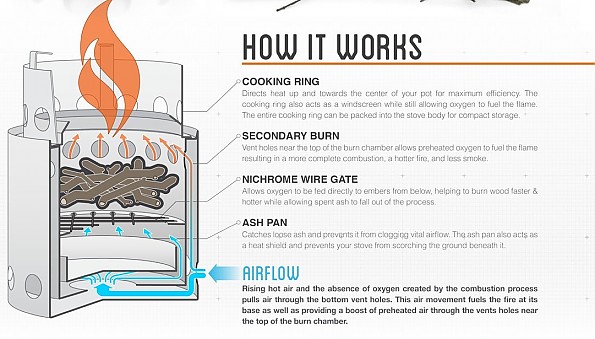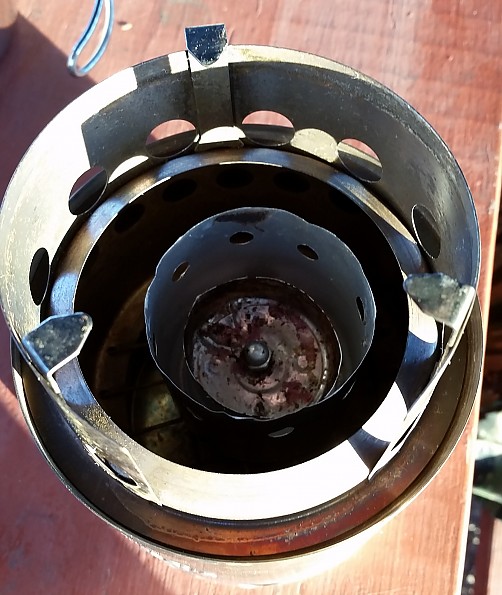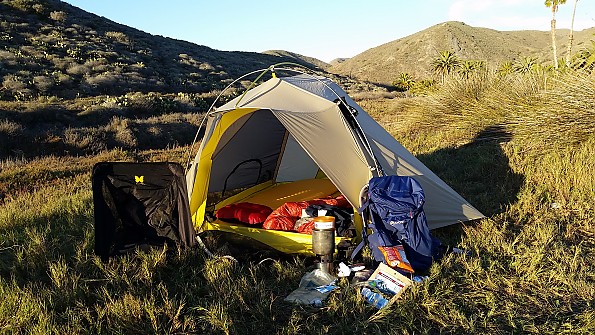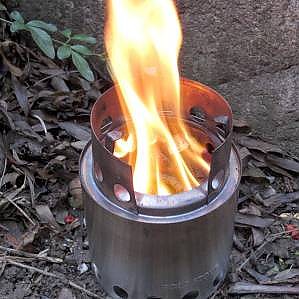Solo Stove Lite

Use an oven grade piece of aluminum foil on top or lightly crimped around the pot to avoid soot on the pot.
Pros
- Like using renewable fuel
- See decooler on Amazon
Cons
- Works better with a windscreen
Works as advertised.
Source: Amazon
An efficient gasifier stove that allows one to use found wood for fuel rather than carrying fuel. While it can be used with any pot or pan that can handle open fire, the Lite nestles within the Solo Stove Pot 900. Best used for boiling water or heating foods for 1-2 people. Recommended for those who don't mind the brief ritual of collecting and preparing natural fuel whenever they wish to use the stove.
Pros
- Proven design provides very efficient use of fuel
- Simple construction and use
- Enclosed design keeps ashes in the stove
- Works with Trangia-style alcohol burners (not included), too
- Competitively priced (compared to similar, handmade options)
Cons
- Learning curve to optimize use
- Requires tending while in use
- Heavier than some woodburning options
- Susceptible to environmental factors


Note: The following review is of a wood-burning stove. All testing of this stove was conducted in accordance with local fire and firewood regulations. When using wood-burning stoves (or campfires), always adhere to local guidelines for fire use. In the United States, the United States Forest Service maintains a Wildland Fire Assessment System, from which are derived Smokey Bear's Fire Danger Today posts. As fire risks increase, fire restrictions may be put in place that limit or ban the use of wood-fueled and other types of stoves. Always observe applicable local policies when using fire or stoves. Additionally, the Leave No Trace organization offers useful guidelines about firewood acquisition and use, some of which are relevant to wood stove use, too—as a rule of thumb, dead-and-down wood is generally acceptable to use as fuel.
Overview
The Solo Stove Lite is a small, double-walled wood stove that can fit inside one's pot for ease of carry. It burns wood, which means one generally does not need to carry additional fuel. It is the smallest of Solo's camp stoves, designed for use by 1-2 people. The larger Titan (for 2-4 people) and Campfire (4+ people) are part of the same line of stoves.
Technically, the Lite is a micro-gasifier biomass (wood) stove: its double-walled design helps to separate wood gas generation and wood gas combustion, creating a combustion zone at the top of the stove. The benefit of a gasifier stove is that it is very efficient, requiring less fuel than other wood-burning options.
The Learning Curve
There is a bit of a learning curve with such a stove. First, it uses wood for fuel, and wood-fired stoves behave differently than do isobutane, solid fuel, or liquid gas stoves. It may require refueling, and it is trickier to cook over a wood flame than the controlled flame of a gas stove.
Second, while one can use the stove with scavenged biomass such as pinecones and twigs, the Lite works most efficiently if one approaches its use as one might approach building a campfire: by taking a few minutes to prepare fuel, one can ensure the most efficient burn.
The stove operates on a TLUD (top-lit updraft) principle; Solo recommends that one light the fire from the top with the fuel already loaded so that the fuel is gradually heated and gasified. Mastering this approach requires some practice, a knack for choosing the best fuels, and some patience in preparing the fuel for the stove.
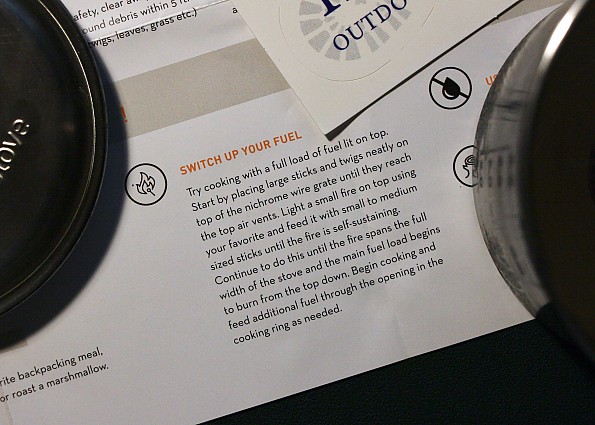
Fuel
A huge advantage of the Solo Stove Lite is that serviceable fuel is generally all around us when we go camping, but be sure to always observe local regulations about stove use and fuel collection (please see Note at the beginning of this review). I live in the Piedmont of North Carolina, USA, an area rich in woodlands and generally spared from fire restrictions; consequently, my only restriction during my testing was to use dead-and-down wood for fuel, and that was found in abundance wherever I camped.
I experimented with using random, dead-and-down fuel from the forest floor such as pinecones, tulip poplar bark, and other fuel finds in the Lite as well as slightly thicker dead-and-down wood that required some processing before use.
Over a period of weeks when I used this stove exclusively to heat my morning coffee water, I settled on my own preferred preparation, which was to use softwood as tinder, a mix of similar diameter softwood and hardwood as kindling, and hardwood as my main fuel--all scaled down, of course, to fit in the stove.
This approach is a scaled-down version of what I do when building a regular fire. With the Lite, then, I often used pine shavings or curls as tinder and small pieces of pine and oak as kindling, then used thicker oak pieces as my main fuel (as shown in the image, below).
As a matter of preference, I often carry a fixed blade knife and a light folding saw (Bahco Laplander) with me when backpacking, and these tools allow me to cut and split the wood to size in a few minutes. Those who may eschew the weight of such tools will need to locate dead-and-down sticks of the necessary diameters and break them by hand.
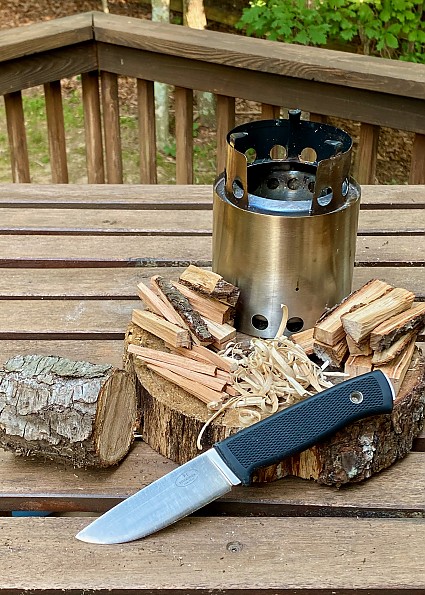
During my weeks of testing, I'd build a fuel base in the stove of thicker wood, allowing always for airflow, then add some smaller diameter pieces, topping all with the easily lit shavings. As the shavings catch, I'd add a few of the smaller diameter pieces of tinder to sustain the burn until the thickest pieces were burning. The initial phase could be a little smoky until the gasifier principle took hold.
The video below shows the wood gas burning in the top combustion area of the stove.
This preparation allowed me to use the TLUD technique that Solo recommends and which burns most efficiently (the more efficiently the gasifier works, the less smoke and soot it will produce). However, it is perfectly possible to use pinecones and twigs and the like, too, or you can start the fire at the bottom of the stove, then add fuel on top of it. Just keep in mind that coniferous woods tend to be pitchy, and using a bottom-lit up-draft method may produce a smokier fire.
The height of the wire mesh in the stove also allows one to use a Trangia-style alcohol burner in the stove in lieu of wood. Solo sells such a burner (simply called "Alcohol Burner"), but I used it with my Trangia (pictured below). This is a convenient option for morning coffee, on a rainy day, or anytime one doesn't want to take the time to use wood as fuel.

Observations from Use
Let me share a list of observations drawn from my experience with the stove. Since every instance of stove use may be different (different weather, available fuel, dampness or dryness of fuel, etc.), I'll frame these as generalizations:
- It can be very efficient. Often, the burn leaves only ashes or very small pieces of charcoal. It's astonishing how efficient the stove is and how it extracts as much energy as possible from the biomass it is fed.

- It can be very satisfying to use. It is liberating to pack without worrying about how much fuel is left in a canister, calculating how much alcohol one needs to bring, or making room for a bottle of liquid fuel in one's pack. While hiking, it is pleasing to think of the weight one left behind by not carrying fuel. Moreover, once in camp, locating the perfect fuel for the stove is also satisfying. All this smug satisfaction peaks when one has a gorgeous, efficient burn going in the stove!
- It can be finicky. Sometimes, that satisfaction can be tempered by the stove's finickiness. Adverse weather requires the stove to be protected somehow—I often used it under the shelter of the edge of my hammock tarp, where the low, contained fire posed no threat to the silpoly roof a considerable way above it. While fuel preparation generally pays off with the Solo Stove Lite, sometimes damp fuel or a lack of oxygen will result in a slow-to-start or smoky fire. Conversely, softwood fuel can result in a furious blaze. The bottom line is that this stove is significantly more difficult to use than a canister, solid fuel, alcohol, or liquid gas stove. Practice and preparation tame the finickiness to a large degree, hence the learning curve.
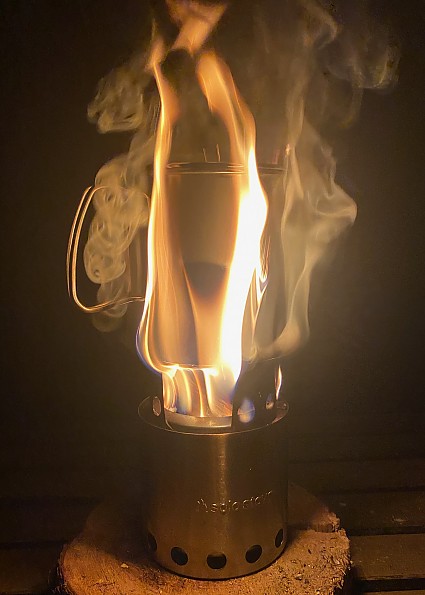
- It's cozy. Caught in a thunderstorm, I hunkered down under a tarp and cooked dinner. As the temperature fell twenty degrees, I enjoyed not only hot food but also the warm glow of the Solo Stove Lite. Staring at a blue flame just isn't the same.

- It can be hungry. This stove is simplest to use if one just wishes to boil water. Longer, more ambitious cooking will almost assuredly require one to feed the fire, so I don't recommend distracting yourself with camp chores while waiting on water to boil or food to cook. The stove, however, is relatively easy to feed: I just shoved fuel into the opening in the pot stand without lifting my pot, occasionally poking it further in with a stick as needed.
- Its fuel needs a flame. Because the fuel is heated to release wood gas, which is then ignited at the top of the stove, add fuel while you still have some flames. Adding a thicker chunk of fuel when flames have nearly subsided can result in the fuel just smoking and one having to coax the fuel back to flame again.
- Its flame needs protection. The Solo Stove Lite works best in no wind or with a windscreen. Any fire is susceptible to wind, and within the stove, the fire is small: the heat transfer to your food or water will be much less if a wind is blowing about the flames. I used a simple, accordion-fold windscreen made of aluminum that I happened to have on hand. The pot rests about 5.75 in/ 14.6 cm above the ground; any screen that can rise a bit above this will likely be adequate to protect the flame.

- It is fairly small. The mouth of the stove is small. The pot supports form a triangle with about 2.25 in/ 5.7 cm between each point. That makes it fine for most solo-sized pots and pans—a TOAKS 500 or 750 ml pot, for instance, Snow Peak's Mini Solo, Soto's New River Pot, an MSR 775 ml Alpine Stowaway, Zebra 12 cm Billy Can, or of course, the Solo Stove Pot 900. A point worth noting here is not a design con but rather a consideration: larger pots and pans can be used, but it will be harder to balance them in the center of the stove, risking instability. And, while flames may wrap up the sides of wider pots or pans, the stove may produce a localized hot spot. Wider pots and pans also limit the efficacy of a windscreen and make it more difficult to discern what the flames are doing beneath the pot or pan, a potential hazard if one is focusing on the food instead of the flames.

- It's quirky for cooking. The usual logic for cooking over wood is to wait until one has a bed of coals, which provides a more uniform cooking temperature than the flaring, shifting nature of flames. The Solo Stove Lite, however, produces flames, and being a gasifier stove, its fuel is mostly exhausted when it reaches a point of coals. That means actual cooking with the Lite (as opposed to boiling water) requires constant attention, moving the pan on or off the heat depending on the flames, and attending to the stove's fuel demands while also keeping track of the state of one's food. Cooking meals from scratch is doable, but the process can be quirky.


Conclusions
The Solo Stove Lite is a sturdy, two-part stove—there isn't a lot that could go wrong with it in the field, and this makes it an uncomplicated choice of stove.
As a biomass stove, it works with found fuel such as twigs or pieces of dry wood cut and/or split to fit in the compact stove. Its gasifier design allows it to burn fuel efficiently under optimal conditions, although—because it depends on burning biomass--environmental conditions (wind, rain, etc.) and fuel factors (hardwood vs. softwood, dry or damp fuel) affect the efficiency of the stove during actual use. The Solo Stove Lite is best used with a windscreen or some sort of wind block (stone, log, etc.).
Because of these factors, the Solo Stove Lite has a learning curve before one becomes a practiced, more efficient user. (Note: the ability to use the stove with an alcohol burner provides a quicker and easier option for heating water or food than using wood, a bonus in terms of flexibility.)
The Lite works best for boiling water, but it works for cooking, too, if one doesn't mind fiddling with the pan as the flame changes and fueling the stove as required.
The simple design works with almost any lightweight pot or pan that can be subjected to open flame, although wider pots and pans are likely to heat less effectively and efficiently or more become unstable over the small stove opening.
The current price of the Lite indicated on the Solo web page is $64.99 (7/18/22). For value, function, and quality of build, the Lite is a competitively priced stove, although there are less expensive, heavier gasifier stoves on the market as well as less expensive, non-gasifier twig stoves. If the Lite ever jumps to the marked-out MSRP price of $89.99, I would strongly recommend that one consider also the lighter, handbuilt Bushbuddy Stove for about $10 more.
Indeed, some stove enthusiasts argue the Solo Stove Lite is a mass-produced copy of the earlier-to-market, hand-built Bushbuddy Stove ($100), which it closely resembles in design. I own a Bushbuddy Mini; it is made with superb attention to detail, excellent craftsmanship, and hand-built care from lighter materials. Those who count ounces or grams—the Bushbuddy Stove is 2.6 oz/ 73.7 g lighter than the Solo Stove Lite—or who prefer to support cottage makers may wish to explore the Bushbuddy offerings. With the Bushbuddy, though, will come a higher price and a longer wait time because the stove is built by hand.
Ultimately, the Solo Stove Lite is a great option for someone with some fire-building experience who can rely on found fuel, and whose stove needs center on water-boiling, reheating, or light cooking for 1-2 people. For such a person, the Lite offers a simple, efficient option at a competitive price. Just remember to check your local fire regulations before you head out on a trip!
Background
For three weeks this spring, I used the Solo Stove Lite and the Solo Stove Pot 900 daily to heat my morning coffee water. I also took the Lite on several overnight backpacking trips, the longest of which was a three-nighter. On these trips, I used the stove to cook pasta sides, boil water, and heat soup. I used it in fair and foul weather (albeit protected from the elements), often in conjunction with the Solo Stove Pot 900. The Solo Stove Lite was one of the latest pieces of backcountry cooking equipment I've used during my four decades of backcountry cooking. I have experience with a wide range of stoves, including those fueled by wood, alcohol, solid fuel, and liquid fuels.
Source: received for testing via the Trailspace Review Corps
(Sample for testing and review provided by Solo Stove)
The Solo Stove is a simple, functional, and well-designed wood (biomass) burning stove. It burns freely available fuel efficiently while leaving no footprint. It has many advantages over other types of stoves while its disadvantages are confined to those inherent to this class of stoves, and not the Solo Stove in itself.
Pros
- No moving parts to break
- Lightweight but durable
- FREE! Fuel can be found just about anywhere
- No carrying/no waste from canisters and other types of fuel
- Quiet and leave-no-trace
- Can be used in combination with home-made alcohol stove
- Comfort of having a small fire
- Airplane and ferry travel friendly
Cons
- More effort and longer boil times than a canister stove
- Produces some smoke and blackens bottoms of cookware
- Wood fires may not be allowed in certain Areas/circumstances
I received this as a prize for being a Trailspace Reviewer of the Month.
Specs per the manufacturer:
- Packed size: Height 3.8 inches, Width 4.25 inches
- Weight: 9 oz (my sample is 8.5 oz)
- Materials: 304 stainless steel, nichrome wire
- Fuel: sticks, twigs, pine cones and other biomass
- Boil time: 8-10 mins (1/2 to 1 liter of water)
Background: When I first started backpacking, compact and lightweight canister stoves were becoming all the rage. Despite the quirky name, the MSR PocketRocket was the first to find its way into my pack and I used it exclusively for over 10 years. The fact that this stove has remained unchanged for nearly 20 years and is still one of the most popular available speaks volumes about its design and ease of use.
Given the solid performance, I was convinced that canister stoves were the way to go. But I struggled with the notorious aspects of canister waste, sourcing, and uncertainty of running out of fuel. A poignant finding of a spent canister in the middle of a Chilean desert (think WALL-E) got me pondering: what are the alternatives?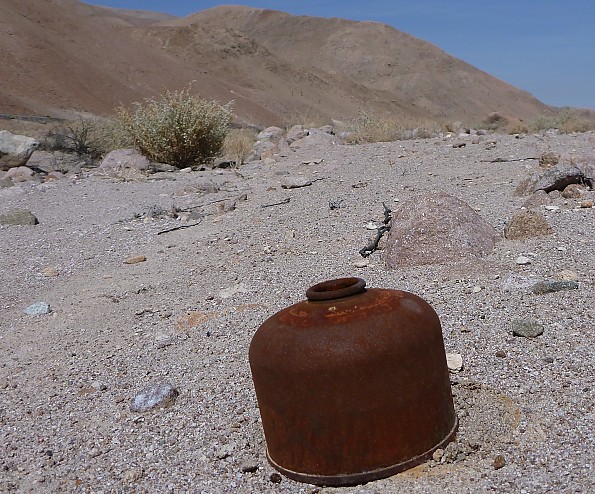
I have since experimented with many of the alternatives, including a homemade alcohol stove, a Jetboil (still a canister stove, but uses fuel more efficiently, therefore less canisters over time) and now, a wood burning stove. ..the aptly named Solo Stove.
The first question one might ask about a wood burning stove, is why not just start a fire? There is actually a huge difference both in the footprint that a campfire makes as well as the efficiency. Even the smallest cook fire, set up on bare ground, sterilizes the soil well below it and leaves a lasting, ugly scar on the land. The heat also dissipates unevenly, not allowing for efficient cooking; considerably more and larger-sized fuel is therefore needed. Perhaps most importantly, an open cook fire can get out of control or not be extinguisher properly, leading to terrible consequences.
A proper wood burning stove, like the Solo Stove, follows leave-no-trace principles by containing a fire and condensing the heat output entirely towards the contents of the cookware. It doesn’t heat the surface it sits on, contains embers well, and burns small twigs so effectively that only a teaspoon of ash is left afterwards. Used wisely and as intended, the Solo Stove can be safe and non-destructive, even in very arid or sensitive areas.
That being said, authorities and land managers may make no distinction between a wood burning stove and a campfire. Thus, using this stove may not be feasible in all areas/seasons (i.e during fire bans, common to the Southwest U.S.). There may also be situations where the collection of fuel is not allowed (though arguably, a single dead branch or small collection of twigs can almost always be discretely and unobtrusively attained). Lastly, there are places where there is just no biomass fuel available (Antarctica, above-timberline). As with any piece of equipment, understanding the conditions that will be encountered and selecting gear accordingly is key.
Setup: The initial setup of the stove could not be simpler, as there are only two parts. For storage, the pot stand ring nestles inside the main container, then flips upright to settle on the stove rim during use.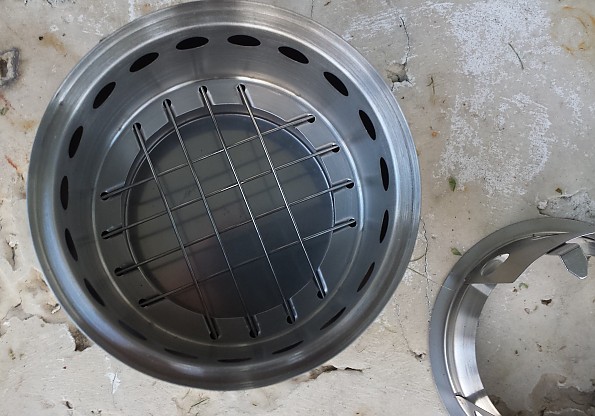
(A brand new, shiny stove. The pot stand ring siting next to it)
(top view of the Solo Stove with the pot stand ring in place)
If the finding and preparation of fuel is considered as part of the setup, then there is obviously more to the story...though not much more. Finding a few small, dead branches can generally be accomplished very easily. If camping in a highly trafficked area, I suggest grabbing one or two on the side of the trail, just prior to reaching camp. I start breaking pieces into suitable sizes as I hike, using a ditty/chalk bag or zip-lock for storage. The size of the bag also establishes a volume to help gauge how much fuel I have/need.
Preparing the fuel is by far the most time-consuming aspect of using the stove. All fuel must be broken down into 1-3 inch sizes. Others have suggested carrying lightweight pruning shears, a knife, or similar tool to cut the pieces. I found my hands worked just fine for small, dry limbs.
DO NOT make the mistake of starting a fire and trying to find, prepare, and feed fuel at the same time. There should be a good supply of prepared fuel PRIOR to beginning a fire, otherwise it will be hard to keep up and the fire will go out, necessitating another start.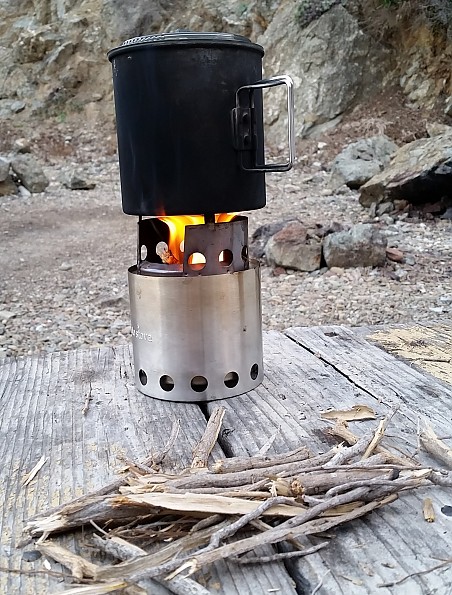
(Here is all the fuel that is needed for one boil...note that I hadn't finished breaking all the twigs into smaller sizes yet.)
Ignition: I find that a single cotton ball smothered in petroleum jelly provides a hot, sustained burn for ignition of just about any other fuel. The cotton can be lit with a lighter or striker. Getting the flame from a lighter down to the cotton inside the stove may be the trickiest part…be ready to jerk your hand back upon flare-up. Other solutions for fire starters are plentiful but a preferred method should utilize inexpensive, easy-to-find, lightweight, non-TSA-alarming materials that can be ready-made and prepared before a trip.

(cotton and small twigs for initial ignition)
As for the actual build of the fuel inside the stove, the Solo Stove website suggests this approach:
“Try cooking with a full load of fuel lit on top. Start by placing large sticks and twigs neatly on top of the nichrome wire grate until they reach the top air vents. Light a small fire on top using your favorite tinder and feed it with small to medium sized sticks until the fire is self-sustaining. Continue to do this until the fire spans the full width of the stove and the main fuel load begins to burn from the top down. Begin cooking and feed additional fuel through the opening in the cooking ring as needed.”
In all my experience using this stove, I haven’t once followed the website’s "full load, top-down" advice, yet still managed to start fires every instance. I did experience several failures in letting the fire go out, mainly because I didn’t feed twigs in frequently enough and then upon realizing my mistake, fed too many, effectively smothering the fire. Which leads me to the next topic…
Flame Control: Finding the fine line between too much fuel and not enough is the real trick with this stove. In theory, flame control is simply a product of more or less fuel but in practice, it’s not as easy to maintain a steady flame. Too little produces smoke or the fire can easily go out. Keep in mind that embers are needed in order to ignite further fuel. Sitting atop the wire grate that allows for ventilation, these embers can fall through as they burn, out of reach for further ignition.
(Here is a brief video of embers after a boil...functional in terms of heating water and also the comforting glow of a small campfire. If re-hydrating food in a pot instead of a foil bag, the pot can be left over the embers to speed up the process and keep the contents from cooling down too much.)
Too much fuel produces a flame that exceeds the top of the stove, lapping up the sides of the pot and out the feeding door. This makes it difficult to add more twigs without risking a burn but to err on this side of the equation is still preferable.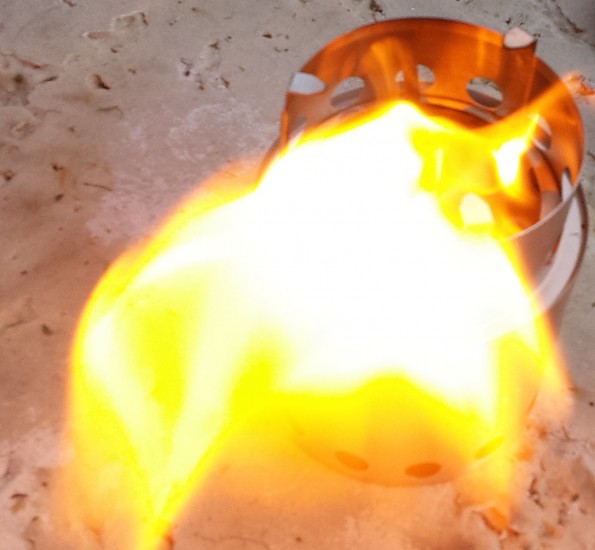
(a bit too much fuel added here)
Throughout a single boil, I experience a lot of peaks and valleys. I’ve learned to be overly generous…not necessarily in adding larger quantities of fuel but rather in adding small amounts more frequently. This is not a stove you can start and just walk away from. It needs constant attention.
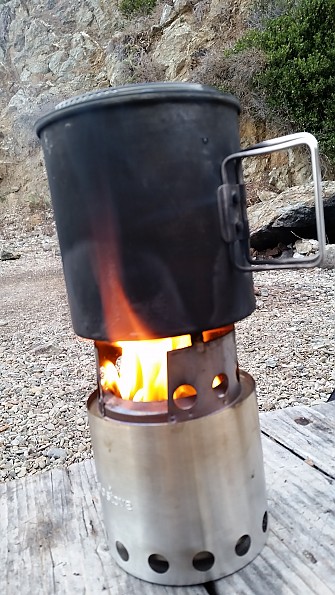
(Just about the right flame for a boil)
Cooking/Boil Time: Boil times can vary by the type and amount of wood used but the manufacturer’s claim of 8-10 minutes for 1 liter is definitely within the ball park. I will say here that the extra time it takes for preparing wood, getting a fire going, boiling, and cooling/clean-up greatly factors into my planning on mornings when an early start is needed. Making sure everything is prepared the night before is a good practice in general but especially important when it comes to ensuring that dry wood is available.
I like to collect enough fuel, before dark, the day before and take measures to ensure my stash is protected from rain/condensation overnight…a big factor in humid areas like Florida. Even still, there was one morning where I simply opted to have a cold coffee and Clif bar for breakfast. Had I the convenience of a canister stove, I probably would have had a hot coffee.
Along this train of thought, while I do enjoy the comfort and simplicity of the Solo Stove, I wonder that for the ultra-mileage, sun-up-to-sun-down, thru-hiker plan, are the added chores of wood burning feasible and/or worth it? As I imagine happens with any piece of gear, sustained use will bring complete proficiency and involve both loving it and hating it. For many, the benefits of not carrying and/or running out of fuel will outweigh the day-to-day chores of fire-making.
Wind: I have not yet tested the stove in conditions that I would qualify as very windy (above 15-20 mph). I did find that some wind helps in the circulation and therefore delivery of oxygen to the fire, making the stove a better performer to a certain point. This is no different than the results obtained from blowing on a fire. But for the same reasons that an open fire can become dangerous in very windy conditions, I would recommend giving strong regard to wind protection when using any wood burning stove.
Fuel Efficiency: This may seem a moot point, since biomass fuel is often limitless. But the stove’s efficiency is still a large part of its prowess. I stated that a good amount of twigs are needed to achieve a boil but when one considers just how little mass a pile of twigs actually represents, the stove is very fuel efficient. This is important in reducing one’s footprint, both in terms of the amount of materials collected, emissions and waste. Needing only a ditty-bag full of twigs means collection takes less time, there is little to no impact on the ecosystem, less carbon is put into the air, and virtually no ashes are left to dispose of.
Stability: The pot stand ring employs three prongs. The virtues of 3 versus 4 prongs can be argued, so I won’t elaborate here other than to say I find the design sufficient. The stability of the stove is no different than that of most canister stoves, with one exception. As the result of continuous fuel feeding, interaction with the stove is much greater. The potential for a spill is therefore increased.
I found this out the hard way, when midway through a boil, I tried to insert a twig with a little too much force and toppled the whole contraption off the picnic table. Luckily it fell away from me (no burns) and onto beach pebbles (no chance of starting a fire). Inadvertently I tested the stoves durability (not one dent!) but had to start the process all over again.
What did I learn? It’s best not to attempt to use the stove on a slanted surface and especially in combination with an elevated one, despite the convenience. This holds true for any stove, which is in essence a controlled fire up to the point that it’s not, because it’s flying through the air!
Packability & Weight: The Solo Stove’s dimensions seem to align perfectly with many commercially available pots, nesting inside for a compact, complete camp kitchen. I use an old GSI anodized aluminum pot, which I got for my first backpacking forays over 15 years ago. The pot is still one of the lightest liter pots I’ve come across and the Solo Stove slides inside with not even a rattle. I use a napkin to prevent chaffing and noise.
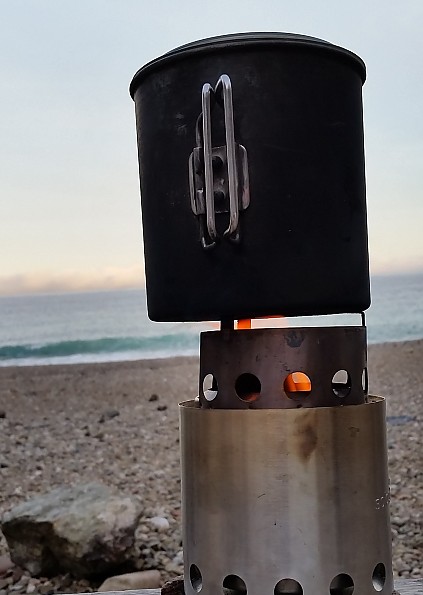
The whole kitchen (stove, pot, lexan lid, cotton/Vaseline fire starter, and ditty/water bag) weighs in at 15.5 oz. This is still heavier than many other configurations, but not when you factor in fuel. Assuming that biomass fuel is of unlimited supply, this same weight will get a person through one night or 20, it matters not. So for an extended journey, the weight savings and peace of mind of not running out of fuel cannot be matched by other stove systems.
Ease of Use: Inherent to the class, ease of use is a disadvantage when compared to canister or even alcohol stove. It simply takes longer to collect fuel, start a fire, and reach a boil. But this is a comparison of apples and oranges. I haven’t tried other wood burning stoves for a fair comparison. But is it easier to start a fire in the Solo Stove than a fire in general? Without a doubt, absolutely! I am lousy at starting fires and I still managed to always get the stove lit. The same can’t be said for all my campfire attempts.
Most users of the Solo Stove express how easy it is to get a fire going…keeping it going follows more of a learning curve, as explained above, and also depends greatly on the conditions. Practice and patience are the operative words, and I’ll leave it at that.
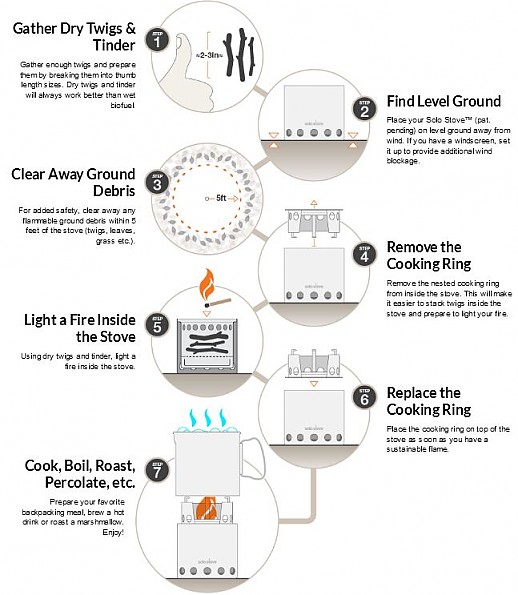
(Here is a simple cartoon from the manufacturer showing the steps involved in using the Solo Stove)
Features: I thought it would be most useful to use Solo Stove’s own product description of the complex combustion process, rather than trying to describe it myself:
“Designed with a double wall, the Solo Stove is a natural convection inverted downgas gasifer stove. Rising hot air, and the absence of oxygen created by the combustion process, pulls air through the bottom vent holes. This air movement fuels the fire at its base while also providing a boost of preheated air through the vent holes at the top of the burn chamber. This burst of preheated oxygen feeding back into the firebox causes a secondary combustion. This allows the fire to burn more complete, which is why there is very little smoke during full burn.”
One other feature worth mentioning is the stove’s capacity to be used in conjunction with parts of an alcohol stove. My homemade tea-candle stove (just the part that contains and burns the alcohol) fits inside the Solo Stove, so that it essentially works as an over-designed screen and pot stand. This adds some versatility in situations where a wood fire may not be feasible.
(Solo Stove serving as the windscreen and pot stand for a homemade alcohol stove)
Construction & Durability: My sample has very clean lines, no exterior seams, and is of solid, quality construction. Out of the box, it was a shiny thing of beauty to behold…this gal’s kind of BLING! I was reluctant to even get it soiled but alas, gear is meant to be used. I’ve dropped the stove on rocks once already, will no ill effects. Thus, it appears to be quite durable as well.
Conditions: I’ve used the Solo Stove for several months in mostly dry and warmer conditions, for trips lasting one to 6 nights. I will continue to experiment in wet and cold conditions, as I find them. I will also experiment with other fire-starters and the suggested top-down fuel build method mentioned by the manufacturer.
Lastly, there has been some contention about the Solo Stove, based on its similarity to another popular design and the company’s pursuit of good reviews. Because I received this stove as a “Reviewer of the Month” gift through Trailspace, there was no decision on my part about the product over another, nor have I been compelled to give a favorable review.
Despite the pre-historic basis that the Solo Stove relies upon, it is a sophisticated design and modern convenience. My sample has been functional and durable and I am pleased to have it as part of my kit, to serve as an alternative to those confounding canisters when appropriate.
Source: received it as a sample, freebie, or prize (Trailspace Reviewer of the Month prize)
A wood burning stove that burns very efficiently thanks to its design which ensures a more complete combustion. It is reasonably compact and made to last thanks to its simple design and stainless steel construction.
Pros
- Free to use—simply use twigs
- Burns efficiently
- Robust construction
- Simple to use
Cons
- Quite heavy in comparison to similar models
- Less efficient after a long burn
- Cost
I already own a Bushbuddy, which I reviewed some time ago, so I was keen to compare the Solo Stove Lite with it. At first glance, they look identical, and they work in the same way. There are just a couple of minor differences.
Surprisingly, as it is essentially the same design, at 251g, the Solo Stove is 73g heavier than the Bushbuddy. That said, it is nearly half the price ($60 as opposed to $100) so the extra 73g may be worth it. Unlike the Bushbuddy, the ash tray is fixed. I'm not sure there is any advantage in either design, it's just a difference. Finally, the pot supports are simpler but, in my opinion, not as robust as the Bushbuddy design.
It is very simple to set up. Simply invert the pot stand which is stowed inside the stove and you're ready to burn wood. The stove works by super-heating air and mixing it with the gases released from the combustion process. This then ignites through holes around the inside of the top of the stove. This means a greater heat output and a more efficient burn so you need less fuel.
In use it performed exactly as the Bushbuddy does; I could not tell the difference. It brought a couple of generous cups of water to a rolling boil in around 10 minutes. I've used it in fairly windy conditions and, with a wind shield, it performed nearly as well. Just be mindful not to over fill it with fuel—small pieces work best. It burns less efficiently if the fuels is above the holes around the inside of the top and you'll end up with longer boiling times and more residue on the bottom of your pot.
I would say this is best for boiling water. Cooking simple pasta meals is possible, but more involved than using gas as it needs to be "fed" and the temperature is not constant, though I have enjoyed cooking an English breakfast on it.
Like any wood burner, the Solo Stove has its limitations. Burning wood is more environmentally friendly than gas, but if you’re careless with it and start a bush fire then all that effort will be wiped out and then some. Therefore, it is understandable they are banned in some places (best to check before you leave). Also, unless you are prepared to carry substantial amounts of wood, they are pretty much useless above the tree line.
In summary, the Solo Stove Lite is very similar to the Bushbuddy, but at nearly half the cost it is well worth considering. The gasifying effect of the Solo Stove means a more efficient burn but it gets choked quicker than a conventional wood burning stove. Being made of steel, there are lighter models on the market such as the Toaks Titanium, but it is likely to last for years if looked after properly.
Background
Evening trips to the local creek for hot drinks. A cooked breakfast to see how it would handle cooking a more complex meal for a longer burn time.
Source: bought it used
Price Paid: £35
A no-brainer stove. With abundant wood availability, this is my go-to backpacking stove.
Pros
- Durable
- Predictable
- Consistent
- Doesn't need packaged fuel
Cons
- Could be lighter
- Design ripoff
- Limited use based on fuel availability
This is an excellent stove, with a few important limitations. First, the good:
This is a two-piece gassifier wood stove with no moving parts—just the stove itself and the pot stand. You drop a few pieces of wood into the stove, light it, stick the pot on top, boil water, reconstitute your stuff, and eat. Very simple.
This stove is a design ripoff, though as eqfan592 points out, not an exact one, of the original Bushbuddy. There seem to be a group of people who absolutely loathe the Solo Stove for this. However, considering the original designer/manufacture of the Bushbuddy never patented the design and seems to be completely accepting of the Solo Stove's existence and marketing strategies, any conflict here seems to be academic, existing solely in the minds of uninvolved fans of one or the other. Samsung/Apple this is not.
The differences between the two stoves in question are minor. The Solo Stove is a bit heavier and a bit more robust. The Bushbuddy is a bit lighter and a bit more delicate. The end. The Bushbuddy is also more expensive. Ok, now it's really the end. Of the comparison, not the review. Bear with me.
I've been using the Solo Stove for around two years and it's performed flawlessly. It takes very little wood to boil water and the gassifier effect causes the wood to burn almost entirely down to ash. As advertised, it takes around 10 minutes to boil a moderate amount of water (2 cups or so).
The stove is stable, though depending on the size of the cooking pot used, the pot stand might be a little small. I use this stove for solo backpacking with a Snow Peak Ti 900 pot and it works great. Solution for stability: don't kick it whilst cooking. The stove fits perfectly inside the pot for packing purposes. It's also fairly strong. I doubt it would crush inside a pack without a pot in which to nestle.
A wind screen is highly recommended in gusty conditions.
The big caveat, as with all wood-burning stoves, is the wood: if you don't have any, it won't work. But considering how easy it is to find small twigs in most backpacking destinations vs. how difficult it usually is to find precise amounts of alcohol/gas (let alone esbit etc.) lying around in the bushes (and I've looked!) I'm usually not too worried when going backpacking without the blankey of packable fuel along to comfort me when I'm feeling weak. Unless it's rainy. Like super rainy. Or on a mountain top where you can't find wood. That would suck.
This stove is best used on trips where the weight of the stove will offset the weight of the fuel you don't have to carry. ie, the longer the trip sans resupply, the more weight you save.
I'd love a lighter-weight (titanium?) model. Are you listening Solo Stove people? Lighter weight please.
Source: bought it new
Price Paid: Don't remember. Bought it 2 years ago (promo for reviews seems to have ended).
Best backpacking stove for me.
Pros
- Burns twigs, wood chips, etc
- Lightweight, compact
- Attractive
- No moving parts, O-Rings
Cons
- After a heavy rain it can be a challenge
I was all set to add a white gas stove of a popular brand to my cart when I saw the ad for the Solo Stove on the page I was on. I had just spent hours researching camp stoves and my mind was pretty well made up, but I had to check it out. I ended up getting the Solo Stove, and I'm happy I saw it in time.
The day it arrived was a rainy one, so I went straight to the back yard for testing. I saw a trick in some of the reviews about cotton balls soaked in petroleum jelly as a fire starter, so I gave that a try. I have to admit, with everything soaking wet it was a bit challenging to get a hot fire going in the stove. It was doable however, and I boiled some water as part of my test.
Since then I've gone backpack camping twice, rained both times, and I was able to boil water without too much trouble. The stove works fine with wet wood but it takes longer to get it going. I don't worry about it anymore, but I would prefer dry weather.
Once the fire gets hot enough boiling a pot full of water takes about three minutes. You may have to feed more fuel once you get it going to boil a pot of water. I have not, nor would I use a larger pan with this. It is best for boiling water with the pot that comes with it. It would probably be unstable with a large heavy pan on top.
My Solo Pot is all black after using it a few times. This don't bother me at all, and I did not try to prevent it from happening (putting soap on it beforehand is supposed to help). I love the way that the stove slides into the pot, it is really compact when you put it in your pack.
I'm really happy with it so I gave it the full 5-star treatment. I think it is a work of art as well as being very tough. It would take a real freak accident to break it. There are no O-Rings to wear out, or any moving parts.
Source: bought it new
Price Paid: $106
An interesting novelty. The idea is great, the reality not so much. No complaints about construction. Has a learning curve to get flame right. Requires constant attention/feeding. Covers pots with soot. Getting fuel just right requires having a saw and hatchet, so forget about weight savings
Pros
- Light enough
- does not require bringing liquid fuel
- no moving parts
Cons
- SLOW
- good burn requires cutting and splitting wood, so weight savings negated by weight of tools
Unlike other reviewers, I am receiving no compensation from either manufacturer or sellers. Received stove as gift, so cost not an issue. I carry a small, liter sized coffee pot because brewed coffee one of the delights to camping, and willing to give up the weight and space for pot and stove. Coffee pot usually boils in about 7 minutes on my svea stove, The solo stove takes 28 minutes, (I timed it multiple times) to boil same amount.
Fuel is tricky. I camp in the northeast and find that small twigs usually have damp bark. Got best result by cutting wood into short pieces and then splitting it. I guess this could be done with a Swiss army knife if you want to devote the time to do it. Found that just using small easily breakable twigs ended up with the coals falling through the wire grate and clogging the air supply.
The stove does work but becomes a time consuming production of getting the fuel just right and constant attending of the fire with frequent blowing to keep it from smoldering. It is not smokeless as some reviewers state, it is just not constantly smokey.
In summary, the stove does work, slowly, with just the right size and type of fuel and requires constant attention. Will not be replacing my old svea, but is an interesting novelty. A hand saw and small hatchet will be able to get the fuel just right, so add several pounds of weight to the actual weight you will need to carry. Would not recommend it for use in areas experiencing frequent rain.
Background
This is my first wood burning backpacking stove. Have been using a svea for over 50 years
Source: received it as a personal gift
Great four-season stove! My experience is with the similar Bush Buddy stove from which the Solo Stove is a knockoff.
Pros
- Efficient heat source for cooking
- Easy to add fuel while stove is cooking
- Does not get hot on the bottom, so will burn or leave a mark on the ground
Cons
- Wood stoves require patience
If for some reason you need to move the stove while it is cooking, it does not get hot on the outside and can, therefore, be moved by hand. While cooking, the bottom does not get hot either. Therefore it is safe to use on a wood table or wood floor of a shelter. This can be important if it is raining. Nor does is score the ground like other wood burning stoves.
The stove is easy add fuel while it is cooking without having to move the pot. This might not be possible on other wood stoves. Almost no ashes are left over at the end of a burn.
Think about gathering appropriate fuel while hiking during the day. Small size kindling is important for fire starting. It may be useful to carry a dry supply of tinder. Small ends of pine branches are my favorite found on the dead end of small branches.
I carry a knife with a wood handle which I use to split small pieces of wood just like one might do for a wood stove in a home. I like having a supply of different size pieces of wood, just as one might do with logs for a fire. I have not needed a piece of dead branch that I have not been able to break by hand.
Yosemite does not allow wood fires and be careful when having to gather fuel when above tree line!
Wood stoves do take patience.
It is a great emergency stove to carry on a long day hike and especially in winter. Some fuels might not work well on cold days below freezing or at altitude.
Emergency or everyday use fire staters are cotton balls mixed with Vaseline (like Vix VapoRub)
I have used this stove extensively on the AT. Fuel is everywhere!
Source: bought it new
The Solo Stove works as advertised, and is an efficient wood-burning stove. It is great for packing where you can find small sticks to use as fuel, which is mostly everywhere. The top rack for the pot has some sharp edges.
Pros
- Efficient
- Sturdy
- Well designed
Cons
- Bulky
- Sharp edges
I read a lot on this and competing stoves before buying the Solo Stove (nearly didn't because it's clearly copied from a previous stove, but IP protection is lacking, so that's life). I used this in a test in my barn before using it on the trail several times, and was very pleased.
It packs easily, though not small, and once you start a few twigs in it, it burns very efficiently and hot (though not without smoke if the wood is a little damp). You do have to feed it occasionally, and faster than you think since it burns efficiently, but it boils water in 5 minutes or so. I used the Solo Pot with it, and it worked great, though the pot becomes hard to clean from the soot on the bottom.
A couple of caveats. There is a little stand that is for a pot, that is removed when starting the fire, then placed on top the stove. While this works well, the edges of this are very sharp so you need to be careful.
The other caveat is to make sure the stove and pot are on a somewhat level surface, since the setup becomes top heavy when you have a pot full of water on top the stove, and it can tip over if you're not careful.
Source: bought it new
Price Paid: $79
Easy to carry, not dependent on fuel canisters, eco-friendly as can be. Perfect for the 3/10-day packer, or bikepacker.
Pros
- Relatively lightweight (no fuel canisters to carry)
- Easy to assemble and start a fire
- Eco-friendly to the max!!
- Good construction and materials
Cons
- Takes some practice to get the flame just right
- Can suck trying to find kindling in a downpour (gotta think ahead)
- Flame not as clean as fueled fire
- Can be unstable
This is my first backpacking stove, and I'm not disappointed at all. When you consider the weight of fuel canisters for other stoves, this one is plenty lightweight enough. I've learned to pack some soaked cotton balls to get the flame started on a rainy stayover.
This stove fits great into the pack; slips right into the Solo Pot, so only one thing to make room for in the pack. A little practice and no problem with getting the flame right where I want it. Keeps me busy (a good thing) tending to the fire; I don't care for the "fire and forget" type, I want to be involved in the process.
Improvements: I wish there were some clamp-on / slip-on "feet" that would give the stove a larger footprint on the ground. It hasn't fallen over yet, but close enough to make me uncomfortable. I could nitpick, but overall, that's it—make it more stable.
I am very happy with the stove and would recommend it to anyone that needs to pack light, fire up easy, and cook efficiently. If that's not enough for you...remember, no more fuel canisters. And, no more trying to find a proper way to dispose of the canisters. I absolutely HATE jerks that leave the empty canisters lying on the ground. Don't be one of those people—go eco-friendly, go Solo.
Source: bought it new
Price Paid: $99
The stove is not a bad stove. I purchased it for the price but upon receiving it, I realized that it is a bit too heavy for backpacking. It was my fault though, a couple of ounces doesn't seem much until you actually hold it. It is heavier than an alcohol stove setup or even a lightweight canister stove and fuel setup. It would be good for a survival kit or cooking one person "solo" meals when camping.
Pros
- Price
Cons
- Weight
- Unstable Pot Support
I tried to post a review on the company's website but they delete all of their negative reviews. The reviews are also doctored on Amazon. On their website, they are offering the stove on sale for $59.95 AND a 5-star review must be written for it in order to make the purchase.
They are certainly in the market to buy reviews—after purchasing one, buyers are enticed to make a positive YouTube review on it to receive a 20 dollar rebate and a 45 dollar rebate for a positive website or blog review.
To top off the cake, they are offering a buy-one-get-one-free for Amazon purchases if buyers make a 5 star review after purchase. Well, I don't need an extra stove and I certainly would not have purchased from them if I knew they were doing this.
I thought it was peculiar when contacting them with questions prior to purchasing the stove but like a fool, I dismissed it. They claimed that they DID NOT take anyone's idea for the stove but instead, simply "improved" upon existing stoves on the market. He has "designed" the Solo Stove after many hours of research and testing done in order to achieve the "perfect dimensions" for the "one of most efficient stoves on the market". Uh, what? I've seen a stove that has the exact same dimensions for years before this one.
They make no mention of where it is made in but it is made in China and the steel is similar to what you get when you buy pots that are made in China.
The pot support is also not very stable with all pots despite their claims. I will try to find a pot that will be more stable on it (probably a Snow Peak 900) and maybe even try to contact Bushbuddy to see if they will sell just the pot support (theirs has 4 tabs on the pot support).
Source: bought it new
Price Paid: $60
One consideration that was important to me was the Solo Stove Lite is two pieces—just plop the cap on and you're good. Just practice making your stick fire.
Pros
- Nothing to "put together"...2 pieces!
- Compact and sturdy design
- No canister garbage
Cons
- Gathering sticks is part of the deal
- Making a tiny fire in 90-degree heat is a drag
- Kinda heavy for a backpacking kit
My brother has a different type of gassifer that works great too, and folds flat...wonderful...BUT in cold weather it was a finger-fumbler. So I decided I didn't want to build a tin fort but have a stove that was ready-to-go.
Also, when I pack up the stove, I leave in the stove a box of matches and a single stick of pine fat wood which I shave off with a pocket knife a few tiny staves as my fire starter. And I toss in two of those never-blow-out birthday candles if the wind's an issue. It's a good system.
I'll still use my canister PocketRocket from time to time, but I'm happy for the LNT aspect of the Solo Stove's tiny ash pile. Overall, it's a great little stove for me.
Background
I've been camping, backpacking, etc. for over 50 years. Started with a Svea123 liquid fuel stove, then went to an MSR PocketRocket, and only this year purchased the Solo Stove Light. I use it almost exclusively for boiling water for coffee, tea, and trail meals.
Source: bought it new
Price Paid: about $70 at REI
Terrible Customer Service.
Pros
- NA
Cons
- NA
I found out after buying that they are prone to rust and didn't want to deal with that so I asked if it could be returned to them for a refund and the phone rep not only agreed but emailed their address. Since they have an office in DFW I brought it by unopened and spoke with TWO representatives on site who told me I would receive a refund.
Fast forward the next week I call after hearing nothing from the company and was told by a CS rep that they would not be issuing a refund but only store credit. I asked why and it was because I didn't have an APPOINTMENT to bring in the Solo stove. Well, this was NEVER mentioned in the initial phone call, initial email, or conversation with TWO reps on site when I came by to return an unopened Solo stove. It's uncanny how a company is able to not honor an agreement for refund and add in undisclosed information after the product is already in their possession.
I asked to speak to a manager and was hung up on. I called back and was told by a new rep, Wanda, that she was the manager and she talked to the CEO John Merris and they would not be processing a refund. I did receive an email after the phone call stating I would get a refund, however upon further calling of PayPal there was no refund actually issued. I then called back to figure out if they had changed their mind and decided to actually issue a refund and they are ignoring my number apparently because I am unable to get through to anyone. How unprofessional. I'm simply asking if the email I received was legitimate or not since PayPal didn't see any refund processed.
Overall I am astounded at the discrepancy of customer service from what I received initially by phone, email, and even on location to what happens when they have your product and actually have to carry through with the refund. Please take this as a warning and avoid doing business with this company.
Source: bought it new
Price Paid: $250
This company and its products speak for themselves. They will not dissapoint.
Pros
- Small footprint
- No working parts
- Solid construction
Cons
- The Lite is smaller than most biomass stoves slightly limiting its function
I already am lucky enough to own the Titan Stove, and am very satisfied with it. We got the regular SoloStove stove to expand our camp kitchen and were not disappointed.
Like all the products from SoloStove, this is made from a sturdy grade of stainless steel, that is very reliable. Starting and maintaining the fire in this stove was a snap. The ported bottom does something that is a huge aid in the burning of the fuel. I dont know what it does/how it works, but the fire burns very well on very little fuel.
We were very surprised at how small the normal stove is on pack up. If you own any of their pots, the stove snugly fits inside, saving space, reducing pack noise, and is just convenient for locating the kitchen wares. Also, we do most of our camping out of kayaks, which eans very little space for gear, and this stove weighs next to nothing and takes almost no space in the gear.
This is a must own for the hiker/boater/lightweight camper.
Background
It's lasted in very wet conditions with no ill effects, always does what it should, and has decent "nesting" options.
Source: tested or reviewed it for the manufacturer (Kept it)
Poor quality stainless steel—it rusts!
Pros
- Uses wood *just like* the Bushbuddy
- Copy of the Bushbuddy stove
Cons
- The stainless steel they used in the first production rusted within 4 months use
- Company refused to exchange or refund
- Company uses gimmicks to get positive reviews
Here's my take on the Solo Stove (Original). The BushBuddy company's owner was not/is not financially backed in the way that the Solo Stove company was funded; thus the stove pattern/type was *copied* with someone looking to capitalize upon the BushBuddy's success.
I purchased a BushBuddy back in 2002 from the maker owner and realized he is a one person CRAFTSMAN, and made YOUR BushBuddy stove to order. He uses QUALITY materials that have stood up to 13 years of wear and tear being used at least 3 or more times a week.
The Solo Stove I purchased was RUSTING OUT WITHIN 4 MONTHS! I contacted 'Customer Service' (A joke!) for a replacement or refund and they told me to go pound sand! "We so sorree!"
If you want a REAL wood burning BACKPACKING stove BUY A BUSHBUDDY FOR YOUR PACK. If you want a POOR QUALITY IMITATION, THEN GET A SOLO STOVE which weighs so much there is no way you'll pack it backpacking!
Source: bought it new
Price Paid: $70
Solo Stove a great camping stove and lightweight.
Pros
- Very light weight
- No gas needed
- Very little wood needed to boil water
Cons
- Have to feed fire constatly to keep flame
- Can only use very small peices of wood for it to burn properly
Received the Solo Stove for Christmas and was very excited. I took it out back for a test run and found it to be very easy to get started and easy to keep burning with very little wood. The stove was cooled down enough in about 3-4 minutes to pack up and move on down the trail, if in the woods.
A main point that I like about the Solo Stove is that the fuel for it is usually found on the forest floor and you don't have to carry gas around in your pack. I can't wait to use it on backpacking trips. I'm sure you will be very satisfied with the stove.
Source: received it as a personal gift
Quick easy way for a meal or coffee for one (possibly two) using just a few dry sticks, pinecones, cattails, etc. Very little smoke if tinder is dry. Can also be used with an alcohol stove as backup. A little expensive but well made!
Pros
- Using small amounts of available fuel found in forest
- Little smoke and fast with dry tinder
- Small size and weight
Cons
- Not so great if everything is wet but can be used as pot stand with alcohol stove.
Easy to pack and use if tinder is dry. Plenty of flame which you can't really control other than by adding more or less fuel. Can boil quickly in around 5-7 min with dry fuel. Windscreen is adequate and burner is stable on a flat surface. I really like mine!
Source: bought it new
Price Paid: $70 US
The stove burns solid fuel like small wood chips, twigs etc. that can readily be found in most environments efficiently and clean.The impact on the environment is minimal.The weight of your pack can be greatly reduced by not having to carry heavy fuel canisters.
Pros
- Sturdy construction
- efficient burning
- independence from fuel that is heavy to carry and sometimes hard to get
- light weight and easy to pack
Cons
- needs a little practice to achieve optimal performance
- soot on cooking gear considerably more than on gas burning stoves
- hard to regulate temperature for simmering

When my Solo Stove arrived I was positively surprised how small and lightweight it was.
The construction is very sturdy and the stove is easy to set up.I decided to give it a try right away in my back yard,even though it was a rainy day.The stove is extremely easy to set up and is very stable.
I gathered some dry wood chips and a bit of birch bark (which is my favourite fire starter).In next to no time I had a fire going. Kind of like in a miniature camp fire ring.
I had a pot with exactly 1 litre of cold water ready to see how long it takes to bring that to a boil.I can not support the 8 min. water boiling claim, but if one is that pressed for time on what is supposed to be a relaxing trip,may be camping is not the right past time. So really,who cares!
The flames were quite high to start with and I made the mistake to wait until the fire had calmed down before I put the pot on the stove, but this is not necessary.
Consequently I had to refeed the fire, which can be easily done, but slowed down the boiling process.
The stove is quite fuel efficient in that respect, but it is a challenge to maintain a simmer, or regulate the temperature at all.
For my style of backpacking kitchen, this will be just fine.Most of my meals only require hot water, but this might not be everybodies game. May be with some practicing time spent one could refine the burning technique.
As I found out even on my first try the stove works well in rain and wind,just as is, without a screen.
I love the simplicity of this stove,no parts that can break down, no maintenance required.The impact on the
environment is minimal,the impact on my budget is not very big either seeing as I won't have to buy fuel
and the initial investment of appr.$70 is not bad compared to a lot of other products out there.
A major advantage is the independence from fuel canisters that are heavy to carry and sometimes hard to find.
In case there should be an absolute fire ban on, I plan to bring one tube of fondue fuel and a little aluminum cover of a tea light,which works very well with this stove as well.
The solo packs away nicely in a small sized cooking pot,so does not eat up extra space in your pack.
Overall I am very pleased with my new solo stove. I will bring it on my PCT trip and I am sure it will serve me well.
Disclosure: At the time of this review, Solo Stove rebated consumers in exchange for product reviews. Compensating for reviews without disclosure of material connections is a violation of FTC endorsement guidelines.
Source: bought it new (Disclosure: At the time of this review, Solo Stove rebated consumers in exchange for product reviews.)
Price Paid: $70 CAD including shipping to Canada
Lightweight and easy to use, this handy stove is a needed addition to any backpacker's gear wish list. It uses small sticks and twigs found laying around any campsite as fuel to boil water at a suprising rate.
Pros
- light weight
- no fuel cannisters
- fast cooking
Cons
- needs wood for fuel
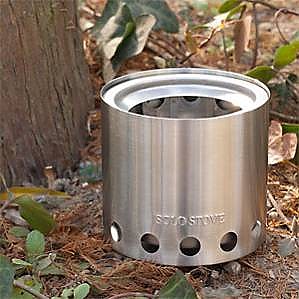
I was tired of buying and lugging fuel canisters every time I went on an overnight trip. Canisters aren’t great in the cold, and even though they can now be recycled I never got past the fact that they need to be recycled. Generally, I used a liquid fuel which required the priming and extra weight of fuel and fuel canister.
This winter in the Wyoming Medicine Bow Mountains, I tried a dry fuel stove – the Solo Stove. The Solo Stove company website is clean and easy to read and contains everything you need to know. I checked reviews and did a little research before buying this product. This stove is not to be confused with the Primus ETA solo stove which uses gas for fuel.
It is however similar to another dry fuel stove. A comparison to that stove is on the Solo Stove website. It looks like the Solo manufacturer wanted a sturdier version of the other stove and found a way to sell it at a lower price. The Solo Stove is definitely a well made and sturdy little unit. That results in a couple of extra ounces of weight as compared to the other dry fuel stove, but I like sturdy and knowing that it will last. Solo Stove weighs in at 9 oz.
There is absolutely no maintenance except disposing of the ash and wiping it down with a cloth to keep it clean. It comes with a light bag, so any soot on the stove stays away from other gear when you are on the trail.
I took the stove out on a two day winter trip. Using just the dry dead twigs from the underside of fir trees I was able to heat up water for oatmeal and cocoa. It is quiet (which I love) and does not expel much heat from the bottom, so could be used easily in our snow hut. The twigs burn down to almost nothing so there were no problems with unburned charcoal or excessive ash. It was stable and held my water cup steady. No priming, no pouring gas, no pumping, cleaning out burners or need to buy/store fuel. Did I mention it was quiet?
I remember years ago being taught that my campfire should be small enough to be able to be contained within a blanket wrapped around my head and body. The Solo Stove makes that a reality and when the fire is out there is no trace on the ground that it ever existed. From my winter camping experience this is the way to go.
I just bought another one for my sister. I am looking forward to seeing how this little stove fares this summer.
Source: Disclosure: At the time of this review, Solo Stove rebated consumers in exchange for product reviews.
Price Paid: $59
This is one of the most well built compact woodgas stoves that I've had the chance to try. It's the same design as the Bushbuddy but is a little heavier as the walls are thicker. The overall construction is impressive and the brushed steel design is very nice. I've used this stove with various fuels including a homemade alcohol stove and it burns really well. I would recommend this stove for any backpackers, survivalists, canoe trekkers, kayakers, who are looking for a solid/multi fuel burning stove.
Pros
- Well built. Solid stainless steel outer shell + integrated pot stand
- A great multi fuel stove (wood, alcohol, esbit). Saves you from buying canned fuel.
- Secondary combustion/gasification vents create a near smokeless burn.
- Requires little fuel to achieve boils. An efficient stove.
- Lightweight at 9oz.
Cons
- As with any wood burning stove, your pot will blacken with soot.
- Difficult to use if wood is wet.
- Takes some practice at getting a fire going.
Setup: Setup is easy. The integrated pot stand nests in the stove so that just needs to get flipped over. It's rests on the stove nicely and securely.
Ignition: I used a cotton ball fire starter to get it going the first time. I piled on small twigs and it was fairly easy to get lit. I also did a second burn where I filled the entire stove with wood then put a lit cotton ball fire starter on top and let it burn down. I prefer the first method.
Flame control: The flame is pretty easy to keep steady but holding a smaller flame takes a little practice.
Cooking: So far I've boiled water and fried a small chicken breast on it. It works well and cooks as expected.
Boil Time: I boiled a cup of water is a few mins.
Wind: The integrated pot stand works as a wind screen and does ok but I do recommend you use a wind screen if there is a strong wind.
Fuel Efficiency: Excellent. I went through 4 burns with wood/twigs I gathered in 5 mins. I didn't weigh the amount of twigs but I'll do that next time. This stove burned the twigs down to a very fine white dust. There was hardly anything left which signifies an efficient burn.
Stability: Fairly stable. Make sure you use it on a flat surface. I was testing it at home on a flat table so it was very steady.
Packability: Fits a Snow Peak Trek 900. It's strong enough to not need to be placed in a pot if you don't have one. If you have a pot, then it makes sense to pack it inside.
Ease of use: It's very straightforward. You'll need to learn how to use a fire starter or tinder to get it going but if you're capable of that, then it's not difficult to use.
Features: The air flow on this stove is excellent. I tested it with an alcohol stove inside just to see how it would burn and the double walled features of this stove helped increase the height of my alcohol stove flame. The inner jets aid in strengthening the flame.
Construction & Durability: This stove is built very strong. The one piece outer construction make is feel like a very finished/polished product. I don't doubt this stove will last a lifetime if taken care of.
Conditions: I've used this stove for 3 weeks now. I plan to take it on a canoe trip this summer.
Disclosure: At the time of this review, Solo Stove rebated consumers in exchange for product reviews. Compensating for reviews without disclosure of material connections is a violation of FTC endorsement guidelines.
Source: bought it new (Disclosure: At the time of this review, Solo Stove rebated consumers in exchange for product reviews.)
Price Paid: $89.99
Your Review
Where to Buy
You May Like
Specs
| nested | assembled | ||
|---|---|---|---|
| Price |
MSRP: $89.99 Current Retail: $69.99 Historic Range: $48.93-$70.00 Reviewers Paid: $59.00-$250.00 |
||
| Weight |
9 oz |
||
| Diameter |
4.25 in |
||
| Height | 3.8 in | 5.7 in | |
| Material |
fully hardened 304 stainless steel, nichrome wire |
||
| Time to Boil |
8-10 min |
||
| Fuel |
Sticks, twigs, pinecones, and other biomass |
||



